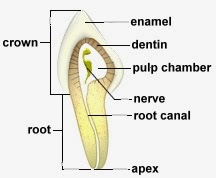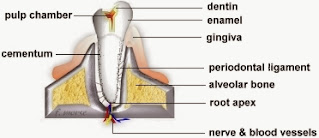Dental Terms to Impress Your Dentist
Blood vessels - carry nutrients to the tooth.
Bone - alveolar bone which forms the tooth socket and provides the tooth with support.
Cemento-enamel junction - the line where the enamel and cementum meet.
Cementum - thin layer of bone-like tissue covering the root of the tooth.
Dentin - the hard yellow tissue underlying the enamel and cementum, making up the bulk of the tooth.
Enamel - the hard, white outer layer of the tooth.
Gingiva - the gums.
Nerves - relay signals such as pain to and from your brain.
Periodontal Ligament - the connective tissue which surrounds the tooth and connects it to bone.
Pulp - located in the center of the tooth, it contains the blood vessels and nerves.
Root canal - canal in the root of the tooth where the nerves and blood vessels pass.
Tooth Structure
 The portion of the tooth visible in the mouth is called the crown. The crown is covered with enamel which is a hard, white, shiny substance. Enamel is highly calcified bone; it serves as the protective layer of the tooth. Enamel is made up of millions of tiny rods which form the framework of the tooth. It's thickest near the biting surface of the tooth and thinnest near the gum line. The color of enamel varies from yellow to white depending on its translucency. The more translucent the enamel, the more the yellow of the underlying dentin shows through. The enamel portion of the tooth has no feeling. Even though it is very hard, it can wear away due to attrition; it may also fracture due to stress.
The portion of the tooth visible in the mouth is called the crown. The crown is covered with enamel which is a hard, white, shiny substance. Enamel is highly calcified bone; it serves as the protective layer of the tooth. Enamel is made up of millions of tiny rods which form the framework of the tooth. It's thickest near the biting surface of the tooth and thinnest near the gum line. The color of enamel varies from yellow to white depending on its translucency. The more translucent the enamel, the more the yellow of the underlying dentin shows through. The enamel portion of the tooth has no feeling. Even though it is very hard, it can wear away due to attrition; it may also fracture due to stress.
The layer underneath the enamel is the dentin. It forms the bulk of the crown and the roots. Dentin is softer than enamel and carries sensations such as temperature and pain to the pulp.
The pulp comprises the innermost portion and is the only soft tissue of the tooth. It supplies nutrients to the tooth and its nerve endings transmit sensations such as pain and temperature.
Cementum forms a very thin layer over the roots of the tooth and is similar to bone. It's yellowish in color and carries sensations to the pulp.
Tooth Types:
Baby Teeth
They are shed and replaced by permanent teeth in the process called exfoliation. Baby teeth are much whiter and less dense than permanent teeth. Thus baby teeth wear much more rapidly than their permanent counterparts. The incisors are used for cutting, the canines for tearing, and the molars for chewing.
Healthy Baby Teeth are Important for:
- Clear speech
- Jaw development
- Efficient chewing
- Maintaining normal facial appearance
- Self-esteem
- Maintaining a proper diet - missing or badly decayed teeth often cause young children to reject foods that are difficult to chew.
- Maintaining space for permanent teeth - prematurely lost primary teeth have a large effect on the way permanent teeth come in Decay and infection in baby teeth can cause dark spots on the permanent tooth developing beneath it.
Permanent Teeth
Permanent teeth may also be referred to as second or adult teeth. They also tend to be slightly more yellow in color than deciduous teeth.
In both the upper (maxilla) and lower (mandible) arch, there are 16 permanent teeth:
- 2 Central Incisors
- Lateral Incisors
- 2 Canines
- 4 Premolars
- 6 Molars
We're out participating at educational conventions and seminars throughout the year and we'd like to use this blog as a dental resource for our community of Phoenix, AZ (and beyond). Of course, we welcome you to join the conversation. Suggest topics and ask those burning questions about dentistry that keep you up at night. Please feel free to contact me through the Morse Family Dental website. Remember, the advice provided here is intended to aid you in understanding some of the treatment options available. It is important to note that before beginning any course of treatment you should always see your dentist.

Comments
Post a Comment